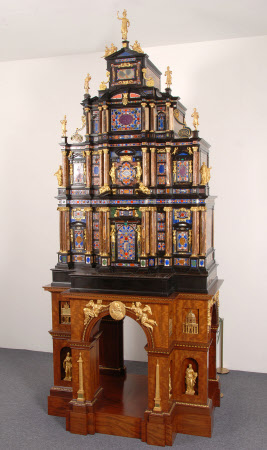Stand
John Boson (c.1696 - 1743)
Category
Furniture
Date
circa 1742 - 1743
Materials
Oak, mahogany veneer, gilding
Measurements
108 x 134 x 90 cm
Place of origin
England
Order this imageCollection
Stourhead, Wiltshire
NT 731576
Summary
A mahogany and parcel-gilt stand, made by unknown cabinet-maker ‘Mr James’ and the carver John Boson (fl. 1696-1743) and probably designed by either Henry Flitcroft (1697-1769) or Michael Rysbrack (1694-1770). Of mahogany veneers on an oak substrate and formed as a quadri-portal Roman triumphal arch. Each side of breakfront form with a projecting central arch and applied with gilded and carved mahogany figures and motifs. The front’s arch centred by a portrait medallion of Pope Sixtus V, upheld by angels, and its piles applied with carvings of Trajan’s column and the Vatican obelisk. The upper register of recesses to the front and both sides with applied giltwood Italianate buildings, the lower niches with statuettes of the Arts, Wisdom (Athene), Abundance (Ceres) and Flora (possibly Peace) all on a deep platform or plinth.
Full description
The Pope’s Cabinet (NT 731575) – made in Rome around 1585 – was, in 1655 and 1665, recorded as raised on a plinth ‘its foot with gilt figures’ and, in 1713, as ‘a large pedestal of black and gilt wood’. In the 16th century, pietre dure cabinets were usually placed on ordinary tables rather than made-to-measure stands. Therefore, it has been suggested that the pedestal described in 1655, 1665 and 1713 was a later Baroque addition. However, the magnificent Roman pietre dure table now at Powis Castle (NT 1181054) has a massive gilt and painted stand, distinctively sixteenth-century in style, which may suggest that the Pope’s cabinet was originally raised on something similar. For an as yet unknown reason, however, in 1742 Henry Hoare II (1705-85) commissioned this new stand for his magnificent cabinet. Simon Jervis and Dudley Dodd dedicated an entire chapter to it in their book on the Stourhead cabinet (Jervis and Dodd 2015, chapter 8, pp. 156-71) and – whilst it was once believed to have been made by Thomas Chippendale Jr., who worked extensively on Stourhead in the early 19th century – we now know that it was made by the unidentified cabinet-maker ‘Mr James’ and embellished with giltwood figures and carvings by the carver John Boson (c. 1696-1743). It is in the manner of William Kent (c. 1685-1742) but no drawings for it have been found, and its design is attributed to either Henry Flitcroft (1697-1769) or Michael Rysbrack (1694-1770). Like the mahogany which veneers the stand, John Boson’s carvings are of the highest quality. His patrons in the 1730s had included Frederick, Prince of Wales at his houses at Leicester Fields, Kew Palace and Cliveden, and – working to the designs of William Kent – he carved a pair of pier glasses and tables for the 3rd Earl of Burlington at Chiswick. Boson’s carvings for this stand were applied to the veneered carcase, then oil gilded. The arch is centred by a gilt medallion of Pope Sixtus V held by angels, after a silver medal (1585-6) by Lorenzo Fragni (1538-1619) and the architecture represented – Trajan's column and the Vatican obelisk, Domenico Fontana’s Scala Santa, Lateran Palace (1587), his Tempietto in the Cappella Sistina, Santa Maria Maggiore (c.1587), the frontispiece for the ‘Mostra dell’acqua Felice’ (1585-7) and Martino Longhi the Elder’s San Girolamo degli Schiavoni (1588) – were all built by, or relevant to, Pope Sixtus V, the original owner of the cabinet. They tie the cabinet and its later stand together and underline and enhance its papal provenance. Conservation in 2006-8 also revealed that two of the figures – St. Peter and St. Paul – which adorn the cabinet, may also have been carved by Boson.
Provenance
Commissioned by Henry Hoare II (1705–1785) c.1742-3 for The Pope’s Cabinet; in 1946, Stourhead, its collections and grounds were given to the National Trust by Sir Henry Hoare, 6th Bt (1865-1947).
Makers and roles
John Boson (c.1696 - 1743), carver Mr James, cabinetmaker possibly Henry Flitcroft (1697 - 1769) , designer possibly John Michael Rysbrack (Antwerp 1684 – London 1770), designer
References
Jervis and Dodd 2015 Simon Swynfen Jervis and Dudley Dodd, Roman Splendour, English Arcadia: the English taste for pietre dure and the Sixtus Cabinet at Stourhead, 2015 Lees-Milne, 1948: James Lees Milne. Stourhead, Wiltshire. London: Country Life for the National Trust, 1948., p. 26
